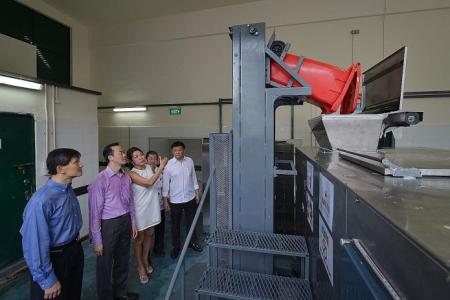HAwker centres test food waste recycling method
Two hawker centres here have been fitted with food waste recycling machines that can cut the total waste generated there by up to 80 per cent.
The National Environment Agency (NEA) launched a two-year trial of the machines yesterday.
The machines are at Tiong Bahru Market and Ang Mo Kio Block 628 Market, which have 342 and 218 stalls respectively. Collectively, the centres generate five tonnes of food waste each day.
The machine at Ang Mo Kio, managed by Eco-Wiz, can convert one tonne of food into water within 24 hours. It works by mixing food waste with microbes, which digest and decompose the waste into water that is reused by the machine.
The recycled water can also potentially be used for non-potable purposes such as to clean the bin centre, said Mr Michael Lee, senior sales manager at Eco-Wiz.
The machine at Tiong Bahru, managed by VRM Operations, grinds up food waste and mixes it with micro-organisms. The resulting mixture is then stored in 1,000 litre capacity tanks. These tanks are transported to an off-site facility every three days where the food waste is converted into fertiliser and used for agricultural purposes.
VRM Operations aims to convert one tonne of food waste per day.
The two companies had won an NEA tender worth about $257,000 to trial food waste recycling machines last year.
The NEA has taught hawkers and cleaners at the two centres how to segregate the waste properly so it can be recycled.
Food waste accounts for about 10 per cent of all waste in Singapore - only about 13 per cent of it is recycled. In 2014, Singapore threw away 788,600 tonnes of food. That was a slight improvement over the 796,000 tonnes in 2013, but still a substantial increase from the 703,200 tonnes in 2012.
Over the past 10 years, food waste has increased by about 48 per cent and is expected to rise further with a larger population.
- The Straits Times.
The percentage by which the price of oil has crashed since mid-2014, hit by oversupply, weak demand and a slowdown in the global economy led by China. Benchmark Brent was trading at US$27.72 a barrel at 10 last night.
By the numbers 75%
Get The New Paper on your phone with the free TNP app. Download from the Apple App Store or Google Play Store now



